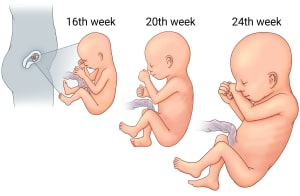The Second Trimester
Prenatal visits during the second trimester
During the second trimester visits, weeks 13-26 gestational age, your healthcare provider may check certain things, depending on your current health and the health of the fetus. The provider may check:
-
Any current symptoms or discomforts
-
Your weight
-
Your blood pressure
-
Your urine with a urine test. This will check for albumin, a protein that may be a sign of preeclampsia or toxemia (high blood pressure due to pregnancy), and it will check for sugar, which may be a sign of high blood sugar (hyperglycemia).
-
Growth, size, and development of the fetus
-
Size of your uterus (after about 12 weeks, the uterus can be felt through the belly wall)
-
Height of the fundus (top of the uterus), starting at 20 weeks
-
Fetal heartbeat
What to expect during the second trimester
The second trimester marks a turning point for the birth parent and fetus. The birth parent often begins to feel better and will start showing the pregnancy more. The fetus has now developed all its organs and systems and will focus on growing in size and weight.
During the second trimester, the umbilical cord continues to thicken as it carries nourishment to the fetus. But harmful substances also pass through the umbilical cord to the fetus. So you need to stay away from alcohol, tobacco, and other known hazards.
During the second trimester, both your body and the fetus continue to grow.
Fetal development during the second trimester
Now that all the major organs and systems have formed in the fetus, the following 6 months will be spent growing. The weight of the fetus will multiply more than 7 times over the next few months as the fetus becomes a baby that can survive outside of the uterus.

By the end of the second trimester, the fetus will be about 14 inches (36 centimeters) long and weigh about 2½ pounds (1.1 kilograms). Fetal development during the second trimester includes:
-
The fetus kicks, moves, and can turn from side to side.
-
The eyes have been gradually moving to the front of the face and the ears have moved from the neck to the sides of the head. The fetus can hear your voice.
-
A creamy white substance (called vernix caseosa, or simply vernix) begins to appear on the fetus. It helps to protect the thin fetal skin. Vernix is gradually absorbed by the skin. But some may be seen on babies even after birth.
-
The fetus is developing reflexes, like swallowing and sucking.
-
The fetus can respond to certain stimuli.
-
The placenta is fully developed.
-
The brain will have its most important time of growth from the fifth month on.
-
Fingernails have grown on the tips of the fingers and toes. The fingers and toes are fully separated.
-
The fetus goes through cycles of sleep and wakefulness.
-
Skin is wrinkly and red. It's covered with soft, downy hair (called lanugo).
-
Hair is growing on the head of the fetus.
-
Fat begins to form on the fetus.
-
Eyelids are beginning to open, and the eyebrows and eyelashes are visible.
-
Fingerprints and toeprints have formed.
-
Rapid growth is continuing in fetal size and weight.
-
The 20th week marks the halfway point of the pregnancy.
A baby born at 24 weeks may survive in a neonatal intensive care unit (NICU).
Changes in your body
The second trimester is the most physically enjoyable for most people. Morning sickness usually lessens by this time. And the extreme tiredness and breast soreness often eases up. These changes are due to a decrease in levels of human chorionic gonadotropin (hCG) hormone. They are also caused by an adjustment to the levels of estrogen and progesterone hormones.
These are the changes and symptoms that may happen during the second trimester:
-
Your appetite may increase.
-
You may be able to feel the fetus move for the first time by 20 weeks. This is called quickening.
-
Your uterus has grown to the height of your belly button. The pregnancy is visible.
-
The skin on your belly may itch as it grows. You may have pain down the sides of your body as your uterus stretches. Your lower stomach may ache. This happens as ligaments stretch to support the uterus.
-
The need to pee (urinate) often may decrease as your uterus grows out of the pelvic cavity. This eases pressure on the bladder.
-
Your nose may get congested. You may have nosebleeds. This is due to the increase in hormones (estrogen and progesterone) that affect the mucous membranes in the nose.
-
Your gums get more spongy and may bleed easily. This is due to the increase in hormones (estrogen and progesterone) that affect the mucous membranes in the mouth.
-
Varicose veins and hemorrhoids may appear.
-
You may have a white-colored vaginal discharge called leukorrhea. (A colored or bloody discharge may signal possible problems. It should be checked right away.)
-
The increasing weight gain may cause backaches.
-
You may have areas of skin darkening on your face or belly. This is due to the pregnancy hormones.
-
Heartburn, indigestion, and constipation may continue.
Online Medical Reviewer:
Janet Campbell RN BSN
Online Medical Reviewer:
Raymond Turley Jr PA-C
Online Medical Reviewer:
William Goodnight
Date Last Reviewed:
9/1/2025
© 2000-2025 The StayWell Company, LLC. All rights reserved. This information is not intended as a substitute for professional medical care. Always follow your healthcare professional's instructions.